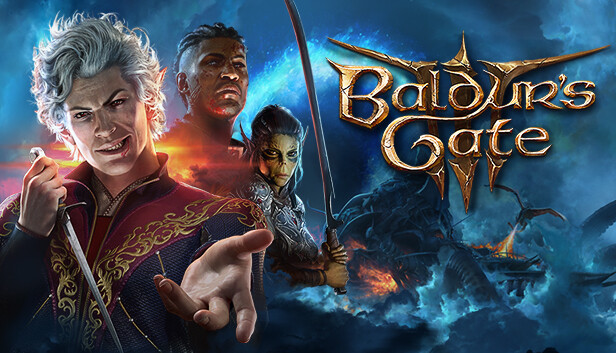The tabletop fantasy role-playing system has fans hooked on this unexpected adventure
By NATALIE SALTER — arts@theaggie.org
Last December, one of the gaming industry’s most anxiously anticipated events of the year, The Game Awards, aired live to an audience of around 118 million viewers. The show’s most prestigious award — Game of the Year, a worthy brag for any game company that has snagged it — sat at the end of the show’s three-hour run. However, a frontrunner had already established itself throughout the event’s duration: “Baldur’s Gate 3,” a fantasy role-playing game (RPG) developed by Larian Studios that, up to that point, had earned nine nominations and five wins — including for Best Performance.
It was “Baldur’s Gate” that came out triumphant here as well, crowned Game of the Year over video game industry juggernauts such as “The Legend of Zelda,” “Super Mario” and “Resident Evil.” “Baldur’s Gate” would go on to receive a number of accolades from various other awards shows, as well as overwhelming acclaim from the most reputable game review sites.
This monumental success was the culmination of six years of effort on the part of Larian Studios and a massive voice-acting and motion-capture cast. Preceded by two other “Baldur’s Gate” games, released in 1998 and 2000 respectively, and under the purview of BioWare and Black Isle Studios, it was the Belgium game company Larian Studios that shouldered the responsibility of creating the series’ next installment.
After successfully earning permission to develop the game from Wizards of the Coast, development launched in 2017. Six years later, after a short early access release, “Baldur’s Gate 3” had a massive global launch on both PC and console gaming systems. It was from here that the game’s initial success snowballed into international acclaim.
Set in the fictionalized realm of Faerûn, the protagonist — either personalized to the user’s choice of class, race, appearance and statistics, or a pre-made character provided by the game — is infected with a parasitic tadpole that transforms them into a tentacled monster if left unchecked. The player finds themself making unlikely allies out of a number of fellow infected individuals, including a vampire and a worshipper of the goddess of darkness. Across hidden groves, underground caverns and sprawling cities, the player and their party are free to explore Faerûn and create their own story.
“Baldur’s Gate” is based on the popular fantasy tabletop RPG “Dungeons and Dragons” (D&D), which Wizards of the Coast also owns. Like “Baldur’s Gate 3,” the expansive universe of “Dungeons and Dragons” is completely open to the whims of the players, who can find endless solutions to puzzles, fights and interactions with other characters. To adapt this sort of free-reign gameplay into one video game, able to be personalized to the player’s own desires, would be a massive undertaking. Open-world games are one genre, choice-based games another and any intersection of the two opens an unimaginable amount of possibilities for gameplay that requires hundreds of voice-acting performances and carefully designed environments.
On top of this challenge, “Baldur’s Gate 3” sought to assume a hyper-realistic graphic style popular among many other successful video games. This demanded extra care and effort to create detailed surroundings that hold up under close scrutiny, as well as well-translated motion capture performances that appear just as human as the actors portraying them. If one removes the story and characters of “Baldur’s Gate” from the equation entirely, this alone is such an incredible achievement for a single game that its slew of awards should come as no surprise.
Just as any passionate fan of “D&D” might hope, “Baldur’s Gate 3” delivers on the freedom of choice that made its source material so widely beloved. At the game’s start, players are given the ability to personally craft a character with a variety of races, classes, backgrounds and skill sets that directly affect their dialogue interactions and combat choices throughout the game. Hair color, tattoos, scars and a variety of unique faces are just a few of the character creation options provided to players in this game.
Furthermore, the game is equipped with an expansive dialogue system within which players can pursue romances, challenge enemies and generally approach each situation in any way they want. The sheer massive amount of dialogue options available during each and every interaction means that every single player’s experience with “Baldur’s Gate 3” will be unique and personalized to their own wishes and worldviews.
This freedom expands to the gameplay as well. While fighting your way through a horde of enemies is always an option, players can use their skills of charisma or intimidation to talk their way out of a battle or can use trickery and clever traps that are limited only to the user’s imagination. While “Baldur’s Gate” has a set overarching story, the way this story progresses in both large and small ways is entirely in the hands of the player.
The video game industry is ever-changing, with huge progress being made regularly as game studios push the boundaries of what is possible for a single game. Gaming experiences are becoming progressively more and more immersive and interactive with each major release. If “Baldur’s Gate 3” is any sign of the future of the industry, video games will only continue to become more expansive than ever. And if you’re looking for a story and a universe to lose yourself in, pick up the controller and enter the world of “Baldur’s Gate” — there are a million stories inside, waiting for you to tell them.
Written by: Natalie Salter — arts@theaggie.org




